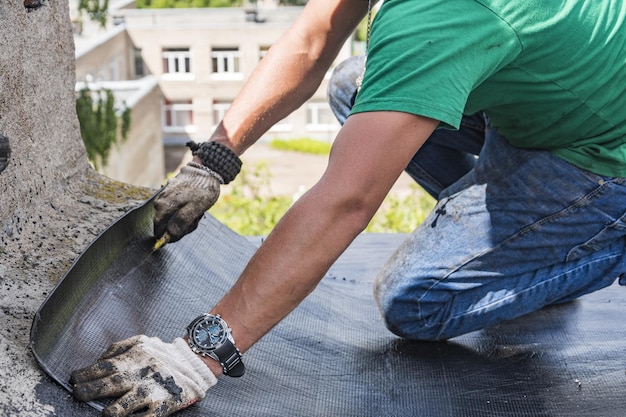How to Install Roll Roofing
by siteadmin

Before beginning to install rolled roofing, first clean the roof surface and apply waterproofing primer or underlayment as an initial protective step. For optimal results, each subsequent layer should overlap its predecessor by four inches – then use roofing cement and nail them into place!
Cost
Roll roofing is a cost-effective and quick option to add an attractive aesthetic to any roof, making it the ideal solution for homeowners needing quick fixes. However, unlike metal or asphalt shingle roofs which last longer and require less maintenance; roll roofing should only be considered on steeply pitched roofs.
Preparing the roof before beginning installation of rolled roofing begins with cleaning it thoroughly and clearing away any debris that might hinder its installation. Furthermore, it's crucial that any holes or damaged wood be addressed immediately as any significant problems must be repaired before continuing with any further steps.
Step two of installing roof replacement materials requires spreading a layer of roofing cement over the entire surface area of the roof, then placing the first course of roofing over it by approximately an inch and nailing it into place using galvanized nails spaced one inch apart – you should then hammer additional nails along cant strips to help avoid stress cracks in future.
Easy to install
Roll roofing is simple to install, provided it's applied over a solid surface and with the addition of roofing felt for additional leak protection and wear resistance. Before commencing installation, clear away debris from your roof before adding waterproof cement for optimal results.
Once this step is completed, line up the first sheet of rolled roofing and press it into wet cement, stretching it out to remove wrinkles. Next, use galvanized roofing nails spaced 6 to 10 inches apart along its entire length for nailing it to. Finally, cap off the end if necessary with an end sheet for completeness.
Starting on the chalk line, start rolling roofing in rows overlapping by 1 inch until reaching the ridge. Don't forget to add a drip edge trim made of either plastic or metal for additional water seepage prevention.
Durability
Roll roofing is an attractive choice for low-sloping roofs due to its easy installation process and relatively low costs, while remaining relatively durable in comparison with asphalt shingles or other options. Longevity of roll roof jobs depends heavily on their condition of sheathing boards as well as quality installation practices – sagging boards could allow water infiltration, thus shortening their lifespan significantly.
Before installing rolled roofing, ensure the surface of the roof is free from debris and clean. Apply a layer of roofing felt underlayment as additional protection from leakage and moisture damage.
Wearing gloves, take a generous scoop of roofing cement and spread it along the edges of the roof. Stretch out any creases in the first layer of rolled roofing before pushing it onto the cement base. Hammer in nails every three inches for added support before covering them up with cement for an elegant finish.
Appearance
Roll roofing provides a similar bumpy texture as asphalt shingles but at an easier and lower cost to install. Roll roof is perfect for low slope roofs as well as structures like gazebos, work sheds, sheds barns and garages.
Installing rolled roofing requires using an effective underlayment to protect it from moisture penetration and extend its lifespan. Underlayment can be purchased at local hardware stores or home improvement centers.
Once the underlayment has been installed, apply a coating of roofing cement. Next, lay out a strip of roll roofing and secure it using nails hammered at 10-inch intervals across the roof. After the first layer has been secured with nails, cut a piece to cover plumbing vents using roofing pieces sealed in cement before proceeding with another layer.
5R Roofing
Before beginning to install rolled roofing, first clean the roof surface and apply waterproofing primer or underlayment as an initial protective step. For optimal results, each subsequent layer should overlap its predecessor by four inches – then use roofing cement and nail them into place! Cost Roll roofing is a cost-effective and quick option to…
Recent Posts
- Enhancing Home Value and Comfort: The Comprehensive Benefits of Investing in Energy-Efficient Windows
- Lawn Care Spring Branch Advocates for Property Care: Combatting Weed Growth and Preserving Curb Appeal
- The Importance of Professional AC Installation in Statesboro, GA
- Understanding Roof Replacement vs. Repair: When is it Time for a New Roof in Lexington?
- Maximizing Home Efficiency and Comfort: The Advantages of Energy-Efficient Windows and Shutters
